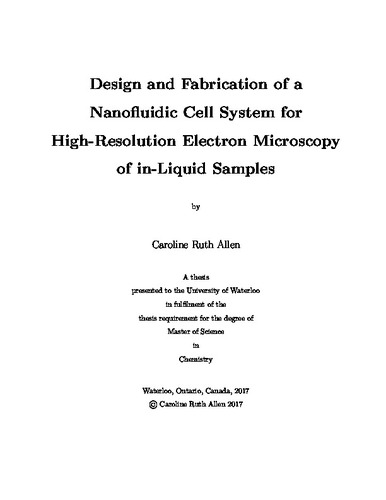| dc.description.abstract | The transmission electron microscope (TEM) has been an important characterization tool since its invention in 1932.[1] The ability to achieve atomic resolution imaging and collect real-time movies, combined with the availability of electron energy loss spectroscopy (EELS) and energy dispersive X-ray spectroscopy (EDX) within the same instrument, make the TEM an indispensable tool for the study of dry solid samples.[1,2] The use of a nanofluidic system (NFS) extends the applications of TEM to include wet solid, liquid, and gaseous samples, opening up a world of possibilities for the direct study of solution or gas phase reactions, dynamics of particles in liquids, cellular structure in its natural state, and more.[3]
In this project, I led the development of a complete NFS for TEM of wet samples and flowing liquid samples. The system consists of a nanofluidic cell to enclose the sample, and a sample holder arm which allows flow of liquid into and out of the TEM. Unlike the typical commercial NFSs available, this system will feature true, controlled liquid flow. The design of the fluidic cell is distinct from other existing designs, and is supported by both the results of flow simulations and experiments performed with larger analogous fluidic cells. All microfabrication was performed by myself and another lab member (Ariel Petruk) in the University of Waterloo's Quantum NanoFab. The sample holder was designed in collaboration with Hitachi High Technologies Canada (HTC), who provided feedback on dimensions to ensure compatibility with Hitachi electron microscopes (EMs) and manufactured the prototype holder. The completed NFS will soon be used in our lab to perform a variety of in-liquid TEM and electron diffraction studies, and will be commercialized by HTC.
The immediate goal of this project is to prove that the NFS works as anticipated: initial experiments will include nanoparticle (NP) uptake in E. coli, using flow conditions to maximize the lifespan of the bacteria in the nanofluidic cell. The study of living (or recently-living) biological cells has the potential to reveal information which cannot be obtained by studying fixated cells. A longer term goal is to use the NFS to study the structure and NP uptake behaviour of brain tumour initiation cells (BTICs); this research would involve collaboration with Dr. Shelia Sing at McMaster University, and would require modification of the electron source of our scanning transmission electron microscope (STEM), which is outside the scope of this thesis. Other future work will include the incorporation of fast mixing and electrochemical functionality in the nanofluidic cell. | en |

